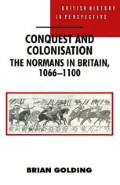Abstract
For most contemporary chroniclers the Norman Conquest was a quarrel in a far-away country between people of whom they knew nothing. Few noticed it: those that did sometimes got its date wrong. Hardly surprisingly, only Anglo-Saxon and Norman writers were concerned with events leading to Hastings, and its aftermath: their interpretations were inevitably coloured either by the despair of defeat or by the triumph of victory.1On one thing alone they were united: in assessing this trial by battle neither blamed the referee— God’s judgement was unquestioned.
Preview
Unable to display preview. Download preview PDF.
Notes
J. Campbell, ‘Some Twelfth-Century Views of the Anglo-Saxon Past’, in Essays in Anglo-Saxon History (London, 1986), pp. 209–28; R. W. Southern, ‘Aspects of the European Tradition of Historical Writing, 4: the Sense of the Past’, TRHS, 5th series, 23 (1973), pp. 246–56.
G. A. Loud, ‘The Gens Normannorum: Myth or Reality?’, ANS, 4 (1981), pp. 104–16.
See R. H. C. Davis, ‘William of Poitiers and his History of William the Conqueror’, in R. H. C. Davis and J. M. Wallace-Hadrill (eds), The Writing of History in the Middle Ages (Oxford, 1981), pp. 71–100.
R. H. C. Davis, ‘The Carmen de Hastingae Proelio’, EHR, 93 (1978), pp. 241–61.
E. M. C. van Houts, ‘Latin Poetry and the Anglo-Norman Court, 1066–1135: the Carmen de Hastingae Proelio’, Journal of Medieval History, 15 (1989), pp. 39–62, with full bibliography.
See N. P. Brooks and H. E. Walker, ‘The Authority and Interpretation of the Bayeux Tapestry’, ANS, 1 (1977), pp. 1–34.
Notably by C. R. Dodwell, ‘The Bayeux Tapestry and the French Secular Epic’, Burlington Magazine, 108 (1966), pp. 549–60.
H. E. J. Cowdrey, ‘Towards an Interpretation of the Bayeux Tapestry’, ANS, 10 (1987), p. 65.
I. Short, ‘Patrons and Polyglots: French Literature in Twelfth-Century England’, ANS 14 (1991), pp. 229–50.
Author information
Authors and Affiliations
Copyright information
© 1994 Brian Golding
About this chapter
Cite this chapter
Golding, B. (1994). The Sources. In: Conquest and Colonisation. British History in Perspective. Palgrave, London. https://doi.org/10.1007/978-1-349-23648-0_1
Download citation
DOI: https://doi.org/10.1007/978-1-349-23648-0_1
Publisher Name: Palgrave, London
Print ISBN: 978-0-333-42918-1
Online ISBN: 978-1-349-23648-0
eBook Packages: Palgrave History CollectionHistory (R0)

